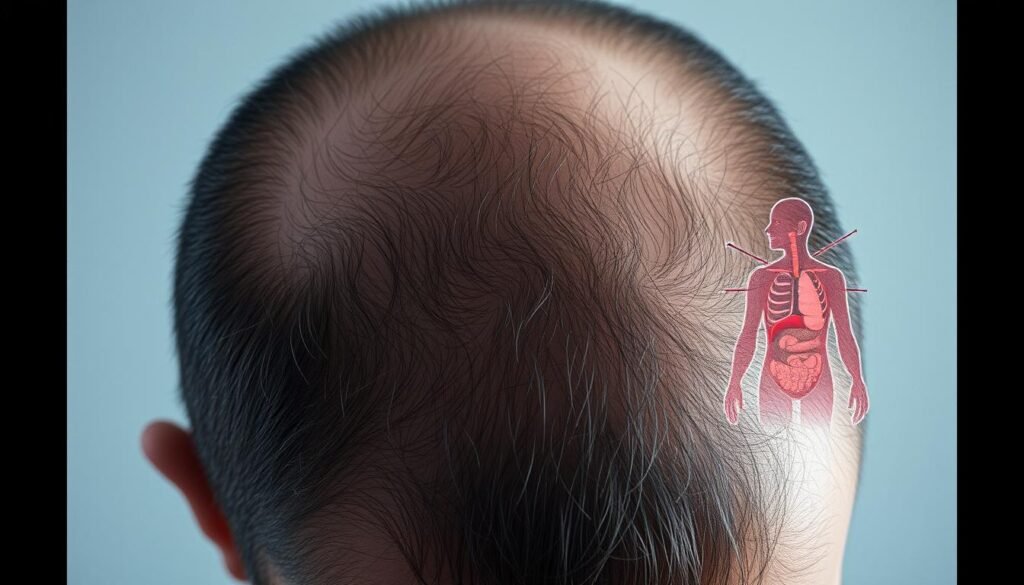Did you know that 2.5% of patients on Avastin face severe bleeding? This fact makes it vital to look at Avastin’s side effects on hair. Since 2004, Avastin has been used to fight cancer. It’s important to ask how it affects hair health.
The link between Avastin and hair thinning deserves attention. We need to see if Avastin alone causes hair loss. Or, does it happen more when used with other treatments? This article will explore how Avastin works, its side effects, and what patients face.
Key Takeaways
- 2.5% of Avastin users have died from serious side effects.
- Avastin is approved for treating various cancers, including those of the breast and colon.
- Some studies suggest that Avastin may lead to hair thinning for some users.
- The drug interferes with the body’s ability to feed tumors, potentially affecting overall health.
- Avastin can cost up to $10,000 a month, making the treatment expensive.
Understanding Avastin and Its Uses
Avastin is a prescription drug used in fighting cancer. It carries bevacizumab and works by blocking VEGF through IV infusions. The FDA has approved it for treating lung, liver, kidney, colorectal, cervical, and brain cancers.
Avastin stops tumors from getting blood, slowing their growth. While fighting cancer, it may cause side effects. These can include stomach issues, skin changes, kidney damage, and high blood pressure. Some reactions can be serious, like blood clots and severe allergies. It’s wise to talk to doctors about these risks.
For details on Avastin, including benefits and risks, check the official information leaflet. It offers a full look at what to expect during treatment.
What is Avastin?
Avastin, known as bevacizumab, is a type of biologic therapy. It focuses on fighting cancer. Unlike usual chemo, it comes from living cells and needs an IV to enter the body. To understand Avastin, know it stops tumor-feeding blood vessels, blocking tumor growth.
Avastin drug information shows it fights several cancers, like those in the lung, liver, kidney, and colon. It’s used under close watch in hospitals or clinics to catch any bad reactions quickly. Some people might feel tired, get headaches, have high blood pressure, or stomach troubles. But, there are more dangerous risks like blood clots and serious bleeding.
Looking at bevacizumab’s effects, it’s clear that while it helps fight cancer, it’s not simple. It has great benefits but also carries risks. Doctors consider both sides when adding Avastin to a cancer treatment plan. This balance helps provide the best care possible.
How Avastin Works in Cancer Treatment
Avastin, or Bevacizumab, is vital in fighting cancer. It works by blocking a protein called VEGF. VEGF helps tumors grow by making blood vessels. By stopping VEGF, Avastin cuts off the tumor’s supply of oxygen and nutrients. This significantly slows down the cancer’s growth.
Avastin is used for many cancers like colorectal, lung, and liver cancer. It’s often given with chemotherapy to make it work better. But, this combination can also increase the risk of side effects. Knowing how Avastin works helps patients understand its importance in cancer care.
Side effects of Avastin can range from high blood pressure to headaches. Some people might experience bleeding or stomach problems. While some side effects are mild and get better, others can be more serious. It’s important to watch for any severe reactions.
| Cancer Type | Common Usage | Side Effects |
|---|---|---|
| Colorectal Cancer | Used with chemotherapy | Headache, high blood pressure |
| Lung Cancer | Used with chemotherapy | Bleeding, fatigue |
| Glioblastoma | Used in combination therapies | Severe emotional disturbances |
| Kidney Cancer | Administered alone or with chemotherapy | Gastrointestinal perforation |
| Cervical Cancer | Part of multi-agent regimens | High blood pressure, infusion reactions |
Avastin plays a key role in stopping cancer from growing. It targets the cancer’s growth pathways. This approach is a major step forward in cancer treatment. It brings hope to many facing different types of cancer.
Common Side Effects of Avastin
Patients using Avastin may face various avastin side effects. These effects vary in how strong they are. Tiredness, nausea, headaches, and high blood pressure are common.
Some serious risks include bleeding issues and wound healing problems. These are a big concern for patients having surgery. Kidney problems may also occur, making treatment harder.
Knowing these common avastin symptoms is key for patients and doctors. Being aware helps start conversations on how to handle these symptoms. This ensures patients get the right help and support quickly.

| Common Side Effects | Severity Level |
|---|---|
| Tiredness | Mild to Moderate |
| Nausea | Mild to Moderate |
| Headaches | Mild to Moderate |
| High Blood Pressure | Moderate to Severe |
| Bleeding Complications | Severe |
| Wound Healing Issues | Severe |
| Potential Kidney Problems | Severe |
Understanding the Side Effects Related to Hair Loss
Avastin, also known as bevacizumab, is key in cancer treatment by stopping blood vessel growth. Although it’s not mainly tied to hair loss, some patients have noted their hair getting thinner as a side effect. This concern adds to the stress of fighting cancer.
It’s vital to know how chemotherapy might affect you, including when using Avastin. Hair loss with Avastin is rarer than with other chemotherapy drugs. Yet, keeping an eye on hair density is crucial. Talking to healthcare providers can shed light on the risks.
Some biological changes due to Avastin may lead to hair thinning. It affects hair follicles, causing noticeable loss. Understanding this helps grasp the wider impact of treatments on your body.
If you notice your hair thinning, talk to your health team. They can advise on treatments to lessen hair loss. This support is crucial for your emotional health during this time.
| Side Effects | Commonality |
|---|---|
| Increased risk of infection | Common |
| Hair loss or thinning | Less common |
| High blood pressure | Common |
| Fatigue | Common |
| Slow wound healing | Less common |
Does Avastin Cause Hair Loss?
When considering using Avastin, many worry about the possibility of hair loss. Is there a real link between Avastin and losing hair? Research gives us a better understanding into Avastin and hair thinning.
Research Findings on Avastin and Hair Thinning
Hair loss concerns those on cancer treatments, but Avastin’s link to thinning hair isn’t clear. Some notice changes in hair during treatment, raising questions. But, studies show Avastin usually doesn’t cause hair loss, a stark contrast to common chemotherapy effects.
Comparisons with Other Cancer Treatments
Avastin and standard chemotherapy work differently, especially in hair loss. Those on chemotherapy often see major hair thinning. However, Avastin mainly avoids this side effect. It stands out for not causing hair loss, though it has other side effects like stomach issues and high blood pressure.
For thorough details on side effects and risks of Avastin, consulting reliable sources is key. Mayo Clinic offers in-depth insights, helping with informed treatment choices.
Avastin Chemotherapy and Hair Loss
When looking into avastin chemotherapy hair loss, it’s key to grasp how chemotherapy works. Hair loss is a frequent side effect of many chemotherapy drugs. This can start about two weeks after the first treatment. Usually, you might see hair come back three to five months after finishing your chemotherapy.
Understanding Chemotherapy Induced Hair Thinning
Chemotherapy can make your hair much thinner. How much hair you lose links to the drugs you’re given. For example, Doxorubicin and Paclitaxel often cause hair loss. However, Avastin usually leads to less hair loss. Around 65% of those getting chemotherapy lose hair to some extent. Whether hair loss is temporary or permanent depends on the drug, its amount, and any other treatments.
The Impact of Combination Therapies
If you’re getting Avastin and other chemotherapy drugs together, you might see more hair thinning. Studies say hormonal therapies could increase hair loss if used with chemo drugs. But Avastin alone usually doesn’t cause a lot of hair to fall out. Talking to your healthcare provider about possible side effects, including hair loss, is important.
Avastin Hair Loss Symptoms
Avastin is often used to treat different cancers. It may cause changes in hair health for some people. Hair loss is rare but can happen. Knowing the signs helps spot hair loss early.
Identifying Signs of Hair Loss Related to Avastin
Look for specific signs if you’re losing hair on Avastin. You might see:
- Thinning of hair: Your hair might not feel as thick as before.
- Increased shedding: You could find more hair falling out when you brush or wash it.
- Change in texture: Your hair might feel more brittle or dry.
- Patchy areas: You might notice bald spots or areas with less hair.
It’s important to recognize these signs early. Doing so lets you seek help quicker. You can talk to a doctor or join a group that understands what you’re going through.
Personal Experiences from Patients
Many share their stories about dealing with Avastin and hair loss. They talk about the emotional side of things and how they cope. Connecting with others in the same boat can provide comfort and support.
Hearing personal stories helps understand that side effects vary per person. Sharing these stories builds a community among those being treated. They offer hope and courage. Check out these patient stories to feel less alone in your journey.

| Symptom | Description |
|---|---|
| Thinning of hair | Less hair density and volume. |
| Increased shedding | Losing more hair than usual when grooming. |
| Change in texture | Hair might be dry or brittle. |
| Patchy areas | Areas on the scalp where hair is noticeably missing. |
Avastin Hair Loss Prevention
Many people treated with Avastin worry about losing their hair. Although Avastin doesn’t directly cause hair loss, there are ways to keep hair healthy. Following certain tips for hair care can really help.
It’s key to take steps to protect your hair. Here are some things to do:
- Choose gentle shampoos and conditioners that keep your hair’s natural oils.
- Avoid using heat styling tools too much to lower hair stress.
- Eat foods rich in vitamins and minerals, especially biotin and zinc.
- Drink plenty of water to stay healthy and keep your hair vibrant.
- Use stress management techniques to help reduce hair thinning from stress.
Even with these tips for hair care, some hair loss might still happen. Many people see some hair thinning. That’s why it’s good to have a full plan for taking care of your hair.
When you focus on these suggestions, you can make your hair healthier. This helps you feel better overall during a tough time.
| Hair Care Tips | Benefits |
|---|---|
| Gentle shampoos and conditioners | Preserves natural oils and minimizes damage |
| Reduced heat styling | Less stress on hair, preventing breakage |
| Balanced diet | Supports hair strength and regrowth potential |
| Hydration | Maintains overall health and moisture balance |
| Stress management techniques | Reduces anxiety and associated hair loss |
Managing Hair Loss with Avastin
Many people deal with hair loss while on Avastin. Finding ways to handle this side effect is important. It can help keep life enjoyable during treatment. Talking to healthcare providers is crucial. They can give advice and support just for you.
Strategies for Patients
There are helpful ways to tackle hair loss with Avastin. Patients can:
- Physical Care: Taking care of your scalp and being gentle with your hair can lessen stress on hair roots.
- Nutritional Support: Eating well, with plenty of vitamins and minerals, supports healthy hair and body.
- Discussing Medication: Chatting with healthcare teams about treatment changes can help lessen side effects.
- Emotional Support: Looking into counseling or support groups can ease the mental toll of losing hair and facing treatment challenges.
Support Mechanisms and Resources
Using the support resources for Avastin can make treatment easier. These resources give important info and emotional support:
- Community Support Groups: Meeting others going through the same thing offers a space to share coping methods.
- Online Forums: Online communities widen understanding of managing side effects.
- Healthcare Provider Guidance: Keeping up with doctor visits helps tweak the treatment as needed.
- Educational Materials: Reading up on treatment and side effects empowers patients on their healthcare journey.

| Resource Type | Description | Benefits |
|---|---|---|
| Support Groups | In-person or online gatherings for sharing experiences. | Builds community and emotional resilience. |
| Online Forums | Digital platforms for discussion among patients. | Wide access to diverse experiences and advice. |
| Educational Materials | Brochures, articles, and videos about Avastin. | Increases knowledge and helps set realistic expectations. |
| Professional Guidance | Consultations with healthcare providers. | Assures well-informed care and personalized strategies. |
Avastin Hair Loss Treatment Options
For those dealing with hair loss from Avastin, there are good options available. These treatments aim to lessen hair thinning and boost your well-being. Starting with a professional consultation is key to finding what works for you.
Potential Medications and Therapies
Many medications and therapies can help with hair loss from cancer treatment. Options include:
- Topical minoxidil, which can stimulate hair regrowth.
- Low-level laser therapy that enhances blood flow to hair follicles.
- Prescription oral medications that may promote hair growth.
Consultation with Healthcare Professionals
It’s important to talk to healthcare experts if you’re losing hair. They can check your health and how you’re doing with treatment. This leads to strategies that are right for you. In these talks, patients can:
- Discuss the potential risks and benefits of various avastin hair loss treatment options.
- Explore effective hair loss therapies that may complement their ongoing cancer treatment.
- Receive guidance on managing emotional and psychological aspects associated with hair loss.
| Treatment Option | Description | Considerations |
|---|---|---|
| Topical Minoxidil | Stimulates hair growth by improving blood circulation to hair follicles. | Daily application; results may vary. |
| Low-Level Laser Therapy | Uses light to enhance cellular activity in hair follicles. | Multiple sessions may be necessary; consult for safety. |
| Prescription Medications | May include anti-androgens or other hormone-based therapies. | Tailored recommendations based on individual health. |
Conclusion
Avastin is a key drug in fighting cancer, but it may cause hair loss for some patients. This avastin treatment summary highlights why it’s vital for patients and doctors to talk about its effects. This includes its impact on hair and overall life quality. Knowing this helps patients choose their treatment wisely.
Studies show hair loss with Avastin is less common than with regular chemo, but it’s still a concern. About 14.7% of patients on targeted therapies like Avastin experience hair loss. This fact underlines the need for hair loss awareness. It’s also important to consider how treatment affects patients emotionally, as many feel different about their body over time.
Being knowledgeable about Avastin’s side effects helps patients feel more in control of their care. Ongoing research, including on natural hair loss treatments, provides hope. Patients should talk to their doctors about all available options. This approach improves their treatment journey and supports their well-being. For those interested in natural hair loss solutions, more information is available here.